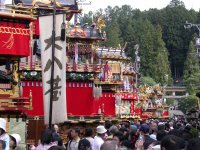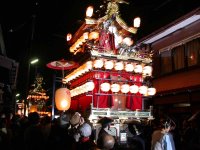
At 6 o'clock in the morning the Buddha downstairs gets up and starts banging away.The Youth Hostel in Takayama is in a practicing temple. At 6 am in the morning the priest, who is also the warden, gets up, starts banging the gong downstairs and chanting.
"Where's my clean underwear?" he grumps at his wife, "What's for breakfast? “Damn - forgot to get any milk out of the freezer last night! Kids up yet?"
I can't sleep through that racket; get up, go for a pee.
I can't get used to the Japanese idea that 'the wall' is 'the door' and 'the d oor' is 'the wall' (or both, or neither). A Japanese hosteller gets up from breakfast, pushes ‘the wall’ to one side and walks through. I do a mental double-take. All the Europeans at the hostel trooped in and out through what we'd conceptualised as 'the door', ie. the two more prominent panels at 'the front' of the ‘dining room'. But 'wall' and 'door' and 'front' and 'back' and 'side' - and indeed ‘room’ - have no meaning in a space which you can treat any which way you want. That whirling sense of Universes shifting.
oor' is 'the wall' (or both, or neither). A Japanese hosteller gets up from breakfast, pushes ‘the wall’ to one side and walks through. I do a mental double-take. All the Europeans at the hostel trooped in and out through what we'd conceptualised as 'the door', ie. the two more prominent panels at 'the front' of the ‘dining room'. But 'wall' and 'door' and 'front' and 'back' and 'side' - and indeed ‘room’ - have no meaning in a space which you can treat any which way you want. That whirling sense of Universes shifting.
Japanese maps and leaflets, though ostensibly full of inf ormation, also give me a sense of dis-location. They don't actually make much sense - to Europeans. The festival information for the festival in Takayama said there would be a procession at 1 o'clock and had the route on the map marked out with little arrows. Fine. I position myself along marked route and wait. And wait. I bump into a German traveller from the hostel and she’s waiting, too. No procession ensues. I go off to the river bank and have a snooze. I learn later that there was a procession, but by a different route, one not marked by arrows. Maps show the inside of your head, not what's on the paper.
ormation, also give me a sense of dis-location. They don't actually make much sense - to Europeans. The festival information for the festival in Takayama said there would be a procession at 1 o'clock and had the route on the map marked out with little arrows. Fine. I position myself along marked route and wait. And wait. I bump into a German traveller from the hostel and she’s waiting, too. No procession ensues. I go off to the river bank and have a snooze. I learn later that there was a procession, but by a different route, one not marked by arrows. Maps show the inside of your head, not what's on the paper.
The Autumn Festival here in Takayama is an annual festival of the Sak urayama Hachimangu Shrine in the northern half of downtown Takayama. The shrine dates back to the time of the Emperor Nintoku (313-399), who entrusted Prince Takefurukuma no mikoto with the task of subjugating the monster Sukuna, a fabulous beast with 2 heads, 4 arms and 4 legs. Before undertaking the task, the warrior enshrined his father, the Emperor Ohjin, as the deity of the shrine and prayed for the success of his mission. Emperor Ohjin is let out every year for the festival and ferried around in massive, ancient, intricately decorated ‘floats’ to see how his people are doing and to bless and succour them.
urayama Hachimangu Shrine in the northern half of downtown Takayama. The shrine dates back to the time of the Emperor Nintoku (313-399), who entrusted Prince Takefurukuma no mikoto with the task of subjugating the monster Sukuna, a fabulous beast with 2 heads, 4 arms and 4 legs. Before undertaking the task, the warrior enshrined his father, the Emperor Ohjin, as the deity of the shrine and prayed for the success of his mission. Emperor Ohjin is let out every year for the festival and ferried around in massive, ancient, intricately decorated ‘floats’ to see how his people are doing and to bless and succour them.
In the evening I head up the main river to find a stance to view the night parade. I bump into Miriam again, the young German women I’ve bumped into several times that day already, so we team up. I’m glad of the company as it’s a bit lonely when the whole town’s parading around with his wife/girlfriend and you’re on your own. But also a feeling of regret, forsaking bitter-sweet loneliness and absolute independence. Suddenly, instead of just doing something, everything has to be negotiated – ‘do you want to go there? Do you want to drink/eat this/that?’
W e find a stance. The progress of the house-high floats is heralded by the simultaneous lightning flashes of thousands of digital cameras and camera-phones. One by one they sway past in the narrow streets on gleaming black and brass wheels 6ft in diameter, pulled and pushed by sweating, gesticulating men. Their myriad red Chinese lanterns flicker in the dark and the shrill of pipes, clang of struck metal, boom of drums and dulcet tones of young children’s voices emanates from their bowels. Miriam and I go to look for a beer and something to eat.
e find a stance. The progress of the house-high floats is heralded by the simultaneous lightning flashes of thousands of digital cameras and camera-phones. One by one they sway past in the narrow streets on gleaming black and brass wheels 6ft in diameter, pulled and pushed by sweating, gesticulating men. Their myriad red Chinese lanterns flicker in the dark and the shrill of pipes, clang of struck metal, boom of drums and dulcet tones of young children’s voices emanates from their bowels. Miriam and I go to look for a beer and something to eat.
I do my washing at the YH, want to hang it out to dry upstairs but the warden's wife scolds me. 'No, not there - outside!' I can't find outside so she sends her daughter to show me. I go off to what the festival programme proclaims is a 'Marionette Performance'. The main piece has incredibly intricate puppets controlled by 6 puppeteers at the same time. I get to the shrine too late and can’t see much over a sea of oohs and ahhs, so I wander off and stumble across an unannounced procession. The god's got out again and is travelling around his domain in much smaller, blue-cloaked carts each pulled by one man. He's accompanied by his kamikose (guardians of the god) in traditional garb - sticky-out shoulder blades (not pads) and large, shallow straw hats; vestal virgins (literally - young girls done up to the absolute nines in long white flowing gowns with flowers in their hair...), loads of little boys in patchy coloured gowns banging gongs and drums, dignified older men in Edo-age dress (Edo - 1655), long swords scraping the pavement with an eerie zishing noise ... and lion dancers at the front. They obviously have a list of places which want to have their demons exorcised (ie they've paid the dancers to come and do it!), so they wend their way slowly around the neighbourhood, doing the lion dance at each of these places.
girls done up to the absolute nines in long white flowing gowns with flowers in their hair...), loads of little boys in patchy coloured gowns banging gongs and drums, dignified older men in Edo-age dress (Edo - 1655), long swords scraping the pavement with an eerie zishing noise ... and lion dancers at the front. They obviously have a list of places which want to have their demons exorcised (ie they've paid the dancers to come and do it!), so they wend their way slowly around the neighbourhood, doing the lion dance at each of these places.
They end up at a staged area alongside a small river, opposite a temple on the other bank and conduct a beautiful, haunting service. On the left the musicians, with shaku-hachi (bamboo flutes), small drums, cymbals and gongs; in front of them, right next to the altar, 4 specially chosen vestal virgins; on the right the older men and dignitaries, all in Edo-style costume. There are actually few onlookers today, and we are allowed into the inner sanctum, nearly up to the stage. The service seems appropriate, fitting. It's not verbose and long, but graceful and flowing. The best bit is when the 4 vestal virgins (literally 'handmaids of the god') get up and dance for him. Ineffably gracious and moving: fans in hand, intricate foot movements, now two to the left, two to the right, sway, form a different combination; intricate movements in perfect synchronity. That angle of the head, and a flowing line from inclined head (to the left), along white samite-draped arm, to fan; hold for an instance, flick of fan, shake of four fans, snap audibly shut, sinuous dip to the left, head upright, glide sideways and turn. I was crying - if I were a god I'd be saying, "yes, that angle, yes, that movement, that ripple of movement!" The girls glide back to their place in front of the musicians and the head h oncho comes to centre stage, sits, bows deeply, and that's that.
oncho comes to centre stage, sits, bows deeply, and that's that.
The little boys scamper off into the temple where they’re fed and watered, leaving their accoutrements haphazardly draped across blackened cedar steps.
